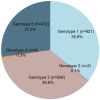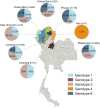Molecular Epidemiology of Hepatitis C Virus Genotypes in Northern Thailand: A Retrospective Study from 2016 to 2024
- PMID: 40700320
- PMCID: PMC12285935
- DOI: 10.3390/idr17040073
Molecular Epidemiology of Hepatitis C Virus Genotypes in Northern Thailand: A Retrospective Study from 2016 to 2024
Abstract
Background: Hepatitis C virus (HCV) remains a significant public health concern in Thailand, with genotype-specific, drug-dependent variations influencing treatment response and disease progression. Despite the availability of pan-genotypic direct-acting antivirals (DAAs), genotype surveillance remains essential for optimizing national elimination strategies. This study thus aims to characterize the molecular distribution of HCV genotypes in northern Thailand. Methods: We conducted a retrospective molecular epidemiological study on 1737 HCV-infected patients who attended the Clinical Microbiology Service Unit (CMSU) Laboratory, Faculty of Associated Medical Sciences, Chiang Mai University between April 2016 and June 2024. HCV genotyping was performed using Sanger sequencing and reverse hybridization line probe assay (LiPA). Results: Genotype 3 was the most prevalent (36.6%), followed by genotype 1 (35.8%) and genotype 6 (27.2%). Subtype 3a (27.2%) predominated, along with 1a (22.1%), 1b (12.6%), and genotype 6 subtypes including 6c to 6l (13.5%) and 6n (6.6%). Males had a higher prevalence of genotype 1, while genotype 3 was more common among females. Temporal analysis revealed a relative increase in genotype 6 prevalence since 2021. Genotype 6 also exhibited significantly higher median viral loads compared to genotypes 1 and 3 (p < 0.0001). Conclusions: This study provides updated evidence on the shifting distribution of HCV genotypes in northern Thailand, particularly the increasing prevalence of genotype 6. These findings underscore the importance of continued molecular surveillance to guide genotype-specific treatment strategies and support Thailand's 2030 HCV elimination goals.
Keywords: HCV genotypes; Thailand; antiviral therapy; genotype distribution; hepatocellular carcinoma; liver disease.
Conflict of interest statement
The authors declare no conflicts of interest.
Figures





Similar articles
-
NIH Consensus Statement on Management of Hepatitis C: 2002.NIH Consens State Sci Statements. 2002 Jun 10-12;19(3):1-46. NIH Consens State Sci Statements. 2002. PMID: 14768714
-
Direct-acting antivirals for chronic hepatitis C.Cochrane Database Syst Rev. 2017 Sep 18;9(9):CD012143. doi: 10.1002/14651858.CD012143.pub3. Cochrane Database Syst Rev. 2017. PMID: 28922704 Free PMC article.
-
Direct-acting antivirals for chronic hepatitis C.Cochrane Database Syst Rev. 2017 Jun 6;6(6):CD012143. doi: 10.1002/14651858.CD012143.pub2. Cochrane Database Syst Rev. 2017. Update in: Cochrane Database Syst Rev. 2017 Sep 18;9:CD012143. doi: 10.1002/14651858.CD012143.pub3. PMID: 28585310 Free PMC article. Updated.
-
Peginterferon alfa and ribavirin for chronic hepatitis C in patients eligible for shortened treatment, re-treatment or in HCV/HIV co-infection: a systematic review and economic evaluation.Health Technol Assess. 2011 Apr;15(17):i-xii, 1-210. doi: 10.3310/hta15170. Health Technol Assess. 2011. PMID: 21473834 Free PMC article.
-
The Genotypes/Subtypes and Antiviral Drug Resistance of the Hepatitis C Virus from Patients in a Tertiary Care Hospital in Nepal.Viruses. 2025 Mar 6;17(3):377. doi: 10.3390/v17030377. Viruses. 2025. PMID: 40143305 Free PMC article.
References
-
- World Health Organization Hepatitis C. [(accessed on 26 November 2024)]. Available online: https://www.who.int/news-room/fact-sheets/detail/hepatitis-c.
-
- Nakamura F., Takeda H., Ueda Y., Takai A., Takahashi K., Eso Y., Arasawa S., Iguchi E., Shimizu T., Mishima M., et al. Mutational spectrum of hepatitis C virus in patients with chronic hepatitis C determined by single molecule real-time sequencing. Sci. Rep. 2022;12:7083. doi: 10.1038/s41598-022-11151-6. - DOI - PMC - PubMed
-
- Borgia S.M., Hedskog C., Parhy B., Hyland R.H., Stamm L.M., Brainard D.M., Subramanian M.G., McHutchison J.G., Mo H., Svarovskaia E., et al. Identification of a Novel Hepatitis C Virus Genotype From Punjab, India: Expanding Classification of Hepatitis C Virus Into 8 Genotypes. J. Infect. Dis. 2018;218:1722–1729. doi: 10.1093/infdis/jiy401. - DOI - PubMed
Grants and funding
LinkOut - more resources
Full Text Sources
Miscellaneous

